Practicing the CBSE Sample Papers for Class 12 Applied Mathematics Set 9 allows you to get rid of exam fear and be confident to appear for the exam.
CBSE Sample Papers for Class 12 Applied Mathematics Set 9 with Solutions
Time Allowed: 3 hours
Maximum Marks: 80
General Instructions:
- This question paper contains five sections A, B, C, D and E. Each section is compulsory.
- Section – A carries 20 marks weightage, Section – B carries 10 marks weightage, Section – C carries 18 marks weightage, Section – D carries 20 marks weightage and Section – E carries 3 case-based with total weightage of 12 marks.
- Section -A: It comprises of 20 MCQs of 1 mark each.
- Section – B: It comprises of 5 VSA type questions of 2 marks each.
- Section – C: It comprises of 6 SA type of questions of 3 marks each.
- Section – D: It comprises of 4 LA type of questions of 5 marks each.
- Section – E: It has 3 case studies. Each case study comprises of 3 case-based questions, where 2 VSA type questions are of 1
mark each and 1 SA type question is of 2 marks. Internal choice is provided in 2 marks question in each case-study. - Internal choice is provided in 2 questions in Section – B, 2 questions in Section – C, 2 questions in Section – D. You have to attempt only one of the alternatives in all such questions.
Section – A
All questions are compulsory. No internal choice is provided in this section
Question 1.
The solution of \(\frac { x – 3 }{ x + 5 }\) > 0, x ≠ – 5, x ∈ R is: [1]
(A) x > 3
(B) x < – 5
(C) x < – 5 or x > 3
(D) no solution
Answer:
(C) x < – 5 or x > 3
Explanation:
Given, \(\frac { x – 3 }{ x + 5 }\) > 0, x ≠ – 5, x ∈ R
Multiply by (x + 5)2
(x + 5) (x – 3) > 0

∴ Solution (- ∞, – 5)∪(3, – ∞)
or x < – 5 x > 3
Question 2.
For two distinct positive numbers x and y. [1]
(A) x + y ≥ 2\(\sqrt{xy}\)
(B) \(\frac { x + y }{ 2 }\) ≥ xy
(C) \(\sqrt{xy}\) ≥ \(\frac { x + y }{ 2 }\)
(D) \(\frac { 2xy }{ x + y }\) ≥ \(\sqrt{xy}\)
Answer:
(A) x + y ≥ 2\(\sqrt{xy}\)
Explanation: For distinct x, y ≥ O;
A.M. ≥ G.M.
⇒ \(\frac { x + y }{ 2 }\) ≥ \(\sqrt{xy}\)
⇒ x + y ≥ 2 \(\sqrt{xy}\)
Question 3.
In a one – kilometre race, A, B and C are three participants. A can give B start of 50 m and C a start of 69 m. The start, which B can allow C, is: [1]
(A) 17m
(B) 18 m
(C) 19m
(D) 20m
Answer:
(D) 20m
Explanation: A : B : C
= 1000 : (1000 – 50) : (1000 – 69)
= 1000 : 950 : 931
In a 950 m race, B can give C a start of (950 – 931) m
= 19m
In a 1000m race. B can give C a start of (\(\frac { 19 }{ 950 }\) x 1000)
= 20m
![]()
Question 4.
Assume that current time is 7 : 00 p.m. what time (in a.m. or p.m.) will it be in 1000 hours? [1]
(A) 7a.m.
(B) 11 a.m.
(C) 11 p.m.
(D) 2 a.m.
Answer:
(B) 11 a.m.
Explanation: We know that time repeats after every 24 hours.
So, we find 1000 (mod 24).
∴ 1000 = 24 x 41 + 16
So, 1000 = 16(mod24)
∴ hours is equivalent to 16 hours.
Now, 7 : 00 p.m. + 16 hours = 11 a.m.
Question 5.
If the matrix A is both symmetric and skew symmetric1 then [1]
(A) A is a diagonal matrix
(B) A is a zero matrix
(C) A is a square matrix
(D) None of these
Answer:
(B) A is a zero matrix
Explanation: If A is both symmetric and skew – symmetric matrices, then we should have,
A’ = A and A’ = – A
⇒ A = – A
⇒ A + A = 0
⇒ 2A = 0
⇒ A = 0
Therefore. A is a zero matrix.
Question 6.
If A is matrix of order m x n and B is a matrix such that AB’ and WA are both defined, then order of matrix B is: [1]
(A) m x m
(B) n x n
(C) n x m
(D) m x n
Answer:
(D) m x n
Explanation: Let, A =[aij]mxn and B = [bij]pxq
B’ = [bji]qxp
Now, AB’ is defined, so n = q
and B’A is also defined, so p = m
∴ Order of B’ = [bji]nxm
And or der of 13 = [bij]mxn
Question 7.
If solving a system of linear equations in 3 variables by Cramer’s rule, we get ∆ = 0 and at least one of ∆x, ∆y, ∆z is non-zero then the system of linear equations has. [1]
(A) no solution
(B) unique solution
(C) infinitely many solutions
(D) trivial solution
Answer:
(A) no solution
Explanation: If ∆ = 0 and at least (one of ∆x, ∆y, ∆z) ≠ 0
The system of linear equations has no solution.
![]()
Question 8.
Nature of the function f(x) = e2x is …………….. [1]
(A) Increasing
(B) Decreasing
(C) Constant
(D) Increasing and Decreasing
Answer:
(A) Increasing
Explanation:
f(x) = e2x
f'(x) = 2e2x
As we know 2e2x > 0, so it always has a value greater than zero.
which shows that function f is increasing for all X ∈ R.
Question 9.
Systems that exhibit exponential growth increase according to the mathematical model y = y0,ekt where y0 represents the initial state of the system and k > 0 is a constant, is called the ………………… constant. [1]
(A) Growth
(B) Decay
(C) Simple
(D) Normal
Answer:
(A) Growth
![]()
Question 10.
The order of the differential equation 2x2 \(\frac{d^2 y}{d x^2}\) – 3\(\frac { dy }{ dx }\) + y = 0 is: [1]
(A) 2
(B) 1
(C) 0
(D) Not defined
Answer:
(A) 2
Explanation:
2x2\(\frac{d^2 y}{d x^2}\) – 3\(\frac { dy }{ dx }\) + y = 0
The highest order derivative present in the given differential equation is \(\frac{d^2 y}{d x^2}\) Therefore, its order is two.
Question 11.
Let X be a discrete random variable whose probability distribution is given below: [1]

(A) \(\frac { 1 }{ 10 }\)
(B) – 1
(C) – \(\frac { 1 }{ 10 }\)
(D) \(\frac { 1 }{ 5 }\)
Answer:
(A)
Explanation:
Here, ∑ Pi = 1
0 + 2K + 2K + 3K + K2 + 2K2 + 7K2 + 2K = 1
9K + 10K2 = 1
10K2 + 9K – 1 = 0
10K2 + 10K – K – 1 = 0
10K (K + 1) – 1(K + 1) = 0
(K + 1)(10K – 1) = 0
K = – 1 and K = \(\frac { 1 }{ 10 }\)
Since, K > 0 therefore K = \(\frac { 1 }{ 10 }\)
Question 12.
If m is the mean of Poisson distribution, then its standard deviation is given by: [1]
(A) \(\sqrt{m}\)
(B) m2
(C) m
(D) \(\frac { m }{ 2 }\)
Answer:
(A) \(\sqrt{m}\)
Explanation: In case of Poisson distribution
S.D = \(\sqrt{mean}\)
Thus, S.D. = \(\sqrt{m}\) [Given, mean = m]
Question 13.
If X is a normal variate with mean μ and standard deviation σ > 0, then the new random variate Z = \(\frac { X – μ }{ σ }\) is a variate with: [1]
(A) Mean = 1, Standard deviation = 0.
(B) Mean = 1, Standard deviation = 1.
(C) Mean = 2, Standard deviation = 1.
(D) Mean = 0, Standard deviation = 1
Answer:
(D) Mean = 0, Standard deviation = 1
Question 14.
Which of the following is not an example of a time series model? [1]
(A) Native approach
(B) Exponential smoothing
(C) Moving average
(D) None of these
Answer:
(A) Native approach
Question 15.
If desired rate of return is minimum by actual rate of return then it is classified as:
(A) future cash flow
(B) present cash flow
(C) positive cash flow
(D) negative cash flow
Answer:
(D) negative cash flow
Explanation: A negative rate of return is a loss of the principal invested for a specific period of time.
![]()
Question 16.
The assumption in calculating annuity is that every payment is: [1]
(A) equal
(B) different
(C) nominal
(D) marginal
Answer:
(A) equal
Explanation: Simple Annuities are annuities where payments are made at the beginning of each period and the compounding period is EQUAL to the payment period.
Question 17.
The accumulated series of deposits as future sum of money is classified as: [1]
(A) marginal fund
(B) nominal fund
(C) sinking fund
(D) annuity fund
Answer:
(C) sinking fund
Explanation: A sinking fund is a separate fund into which one makes a uniform series of money deposits (A) to accumulate a desired future sum (F) by the end of period n.
Question 18.
A company buys a machine at a cost of ₹ 5000. The company decides on a salvage value of ₹ 1000 and a useful life of 5 years, then annual depreciation cost is: [1]
(A) ₹ 500
(B) ₹ 600
(C) ₹ 700
(D) ₹ 800
Answer:
(D) ₹ 800
Explanation: We know that Annual Depreciation expense
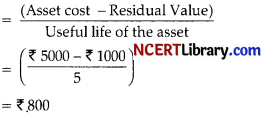
DIRECTION: For questions 19 and 20, two statements are given – one labelled Assertion(A) and the other labelled
Reason (R). Select the correct answer to these questions from the codes (A), (B), (C) and (D) as given below:
(A) Both assertion (A) and reason (R) are true and reason (R) is the correct explanation of assertion (A).
(B) Both assertion (A) and reason (R) are true and reason (R) is not the correct explanation of assertion (A).
(C) Assertion (A) is true but reason (R) is false.
(D) Assertion (A) is false but reason (R) is true.
Question 19.
Assertion (A):

is such that A2 = I, then
1 + α2 + βγ = 0
Reason (R):

is such that A2 = 1, then
1 – α2 – βγ = 0
Answer:
Option (D) is correct.
Explanation:
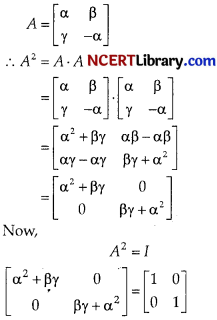
On comparing the corresponding elements, we have:
α2 + βγ =1
α2 + βγ – 1 = 0
1 – α2 – βγ = 0
![]()
Question 20.
Assertion (A): The slope of normal to the curve y 4x2 – 14x + 5 at x = 5 is – \(\frac { 1 }{ 26 }\)
Reason (R): The slope of the tangent at x = 5 is given by \(\frac { dy }{ dx }\)|x=5
Answer:
Option (A) is correct.
Explanation: The slope of the tangent at x = 5 is given by
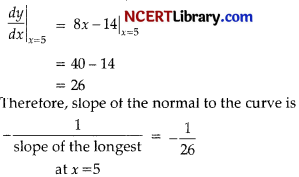
Section – B
All questions are compulsory. In case of internal choice, attempt any one question only
Question 21.
If x = – 9 is a root of

then find the other two roots. [2]
OR
Find the inverse of the matrix

Hence, find the matrix P satisfying tIe matrix equation

Answer:

Expanding along R1,
x(x2 – 12) – 3(2x – 14) + 7(12 – 7x) = 0
x3 – 12x – 6x+ 42 + 84 – 49x = 0
x3 – 67x + 126 = 0 …………(i)
Here, 126 x 1 = 9 x 2 x 7
For x = 2,
23 – 67 x 2 + 126 = 134 – 134 = 0
Hence, x = 2 is a root.
For x = 7,
73 – 67 x 7 + 126 = 469 – 49 = 0
Hence, x = 7 is also a root.
OR

Question 22.
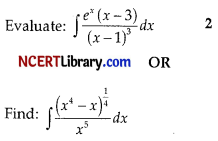
Answer:
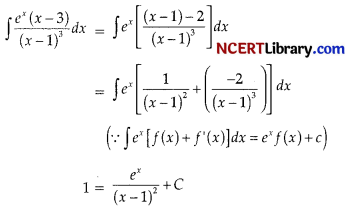
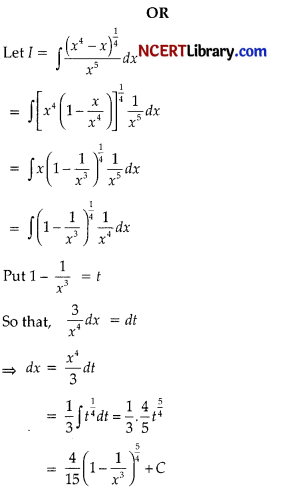
![]()
Question 23.
Consider the following hypothesis:
H0: µ = 36
H1 : µ ≠ 36
A sample of 81 items is taken whose mean is 37.5 and the standard deviaon is 5. lest the hypothesis at 5% level of significance.
(Given: Critical value of Z for a two-tailed test at 5% level of significance is 1.96] [2]
Answer:
Given hypothesis:
H0: µ = 36
H1 : µ ≠ 36
Also, given sample mean (\(\bar{X}\)) = 37.5
Sample size (n) = 81
Standard deviation (σ) = 5
Let test statistics be given by
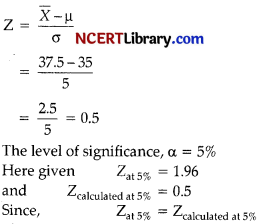
Question 24.
Define secular trend and seasonal variations. [2]
Answer:
Secular Trend: It is a general tendency, of time series to increase or decrease or stagnates during a tong period of time. An upward tendency is usually observed in (he population of a country, production, sales, prices in industries, the income of individuals etc., A downward tendency is observed in deaths, epidemics, prices of electronic gadgets, water sources, mortality rate etc.
Seasonal Variations: Seasonal variations refer to the changes that take place due to the rhythmic forces which operate in a regular and periodic manner. These forces usually have the same or most similar pattern year after year. When we record data weekly, monthly or quarterly, we can see and calculate seasonal variations. Thus, when a time series consists of data only based on annual figures, there will be seen no seasonal variations. These variations may be due to seasons, weather conditions, habits, customs or traditions.
For example, selling of umbrellas and raincoats in the rainy season, sales of cold drinks in the summer season, crackers in Deepawali season, purchase of dresses in a festival season, sugarcane in Pongal season.
Question 25.
A lot of 100 watches is known to have It) defective watches. If 8 watches are selected (one by one with replacement) at random, what is the probability that there will be at least one defective watch? [2]
Answer:
Probability of defective watch from a lot 100 watches
= \(\frac { 10 }{ 100 }\) = \(\frac { 1 }{ 10 }\)
p = \(\frac { 1 }{ 10 }\) q = \(\frac { 9 }{ 10 }\) n = 8 and r ≥ 1
P(r ≥ 1) = 1 – P(r = 0)
= 1 – 8C0 (\(\frac { 1 }{ 10 }\))0 (\(\frac { 9 }{ 10 }\))8-0
= 1 – \(\frac { 8! }{ 0!8! }\)(\(\frac { 9 }{ 10 }\))8 = 1 – (\(\frac { 9 }{ 10 }\))8
Section – C
All questions are compulsory. In case of internal choice, attempt any one question only
Question 26.
A wholesaler in apples claims that only 4% of the apples supplied by him are defective. A random sample of 600 apples contained 36 defective apples. Calculate the standard error concerning good apples.
OR
A machine which produces mica insulating washers of use in the electric devices is set to turn out washers having
a thickness of 10 mils (1 mil = 0.001 inch). A sample of 10 washers has an average thickness of 9.52 mils with a standard deviation of 0.60 mil. Find out t.
Answer:
Sample size = 600
No. of defective apples = 36
Sample proportion P = \(\frac { 36 }{ 600 }\) = 0.06
Population proportion P = probability of defective apples = 4% = 0.04 ,
Q = 1 – P
= 1 – 004 = 0.96
The S.E. for sample proportion is given by S.E.
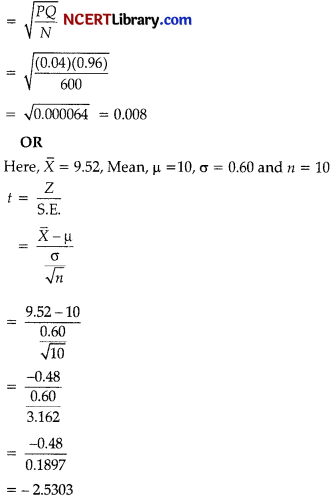
Question 27.
From the following time series obtain trend value by 3 yearly moving averages. [2]
| Year | Sales (in ₹ 000) | Year | Sales (in ₹ 000) |
| 2008
2009 2010 2011 2012 2013 |
8
12 10 13 15 12 |
2014
2015 2016 2017 |
16
17 14 17 |
Answer:
Calculation of trend values by three yearly moving average method.
| Years | Sales
(Thousand ₹) |
Three-yearly
Moving Totals |
Three-yearly
Moving Average (Trend value) |
| 2008
2009 2010 2011 2012 2013 2014 2015 2016 2017 |
8
12 10 13 15 12 16 17 14 17 |
(8 + 12 + 10) = 30
(12 + 10 + 13) = 35 (10 + 13 + 15) = 38 (13 + 15 + 12) = 40 (15 + 12 + 16) = 43 (12 + 16 + 17) = 45 (16 + 17 + 14) = 47 (17 + 14 + 17) = 48 |
10.00
11.67 12.67 13.33 14.33 1500 15.67 16.00 |
![]()
Question 28.
An interviewer gives the following graph on a client’s sales in the last 7 years to candidate and said find the CAGR. Given that \(\left(\frac{9}{4}\right)^{\frac{1}{7}}\) = 1.1228. [2]
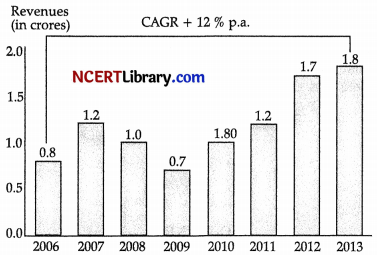
Answer:
Sales in 2006 were 0.8 crores (beginning value). In 2013, after 7 years, sales increased to 1.8 crores.
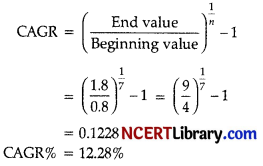
Question 29.
Solve the following linear programming problem graphically: [2]
Minimize: Z = 6x + 3y

Answer:
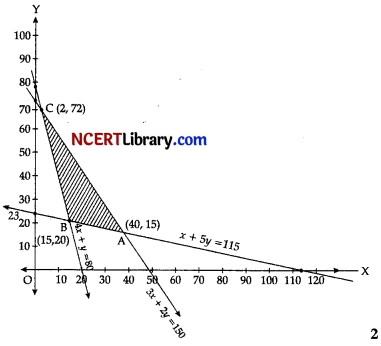
| Corner points | Value of Z |
| A(40, 15) | 285 |
| B(15, 20) | 150 → b minimum |
| C(2, 72) | 228 |
Minimum Z = 150
when x = 15, y = 20
Question 30.
A firm anticipates an expenditure of ₹ 5,00,000 for plant modernization at end of 10 years from now. How much should the company deposit at the end of year into a sinking fund earning interest 5% per annum.
[Given log 1.05 = 0.0212, antilog (0.2120) = 1.6291] (2)
Answer:
Given, A = ₹ 5,00,000, r = 5% and n = 10
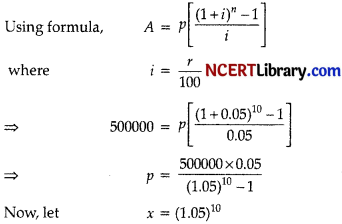
Taking log both sides, we get
Iog x = 10 log (1.05)
= 10 x 0.0212
= 0.2120
x = antilog (0.2120)
= 1.629
Thus, (1.05)10 = 1.629
p = \(\frac { 500000 x 0.05 }{ 1.629 – 1 }\)
= \(\frac { 25000 }{ 0.629 }\)
= 39745.63
Hence, the company should deposit ₹ 39745.63 every year into the sinking fund.
Question 31.
Find (186 x 93) mod 7. [2]
OR
When 783 x 657 x 594 x 432 x 346 x 251 is divided by 5, then find remainder.
Answer:
We know that,
a . b (mod n) ≡ a(mod n) . b(mod n)
So, (186 x 93)mod 7 ≡ 186(mod 7) . 93(mod 7)
≡ 4(mod 7). 2(mod 7)
≡ 4.2 (mod 7)
≡ 8(mod 7)
≡ 1(mod 7)
OR
Since, 783 ≡ 3(mod 5)
657 ≡ 2(mod 5)
594 ≡ 4(mod 5)
432 ≡ 2(mod 5)
346 ≡ 1(mod 5)
and 251 ≡ 1(mod 5)
So, (783 X 657 X 594 X 432 X 346 X 251) mod 5
≡ (3 x 2 x 4 x 2 x 1) mod5
≡ 48(mod 5)
≡ 3(mod5)
Hence, the remainder when (783 X 657 X 594 X 432 X 346 X 251) is divided by 5 is 3.
Section – D
All questions are compulsory. In case of internal choice, aftempt any one question only
Question 32.
A manufacturing company makes two types of teaching aids A and B of Mathematics for class X. Each type of A requires 9 labour hours for fabricating and 1 labour hour for finishing. Each type of B requires 12 labour hours for fabricating and 3 labour hours for finishing. For fabricating and finishing, the maximum labour hours available per week are 180 and 30 respectively. The company makes a profit of ₹ 80 on each piece of type A and ₹ 120 on each piece of type B. How many pieces of type A and type B should be manufactured per week to get a maximum profit? Formulate this as Linear Programming Problem and solve it. Identify the feasible region from the rough sketch. [5]
Answer:
Let the number of two types of teaching aids A and
B be x and y, respectively.
Write the given data in tabular form as following:
| Item | No. of aids | Time on fabricating (in. hrs) | Time on finishing (in hrs) | Profit (in ₹) |
| A | X | 9x | X | 80x |
| B | y | 12y | 3y | 120y |
| Total | x+y | 9x + 12y | X + 3y | 80x + 120y |
| Availability | 180 | 30 |
The profit on type A is ₹ 80 and type B is ₹ 120. Thus,
the required LPP is
Max. Z = 80x + 120y …..(i)
Subject to constraints
9x + 12y ≤ 180
or 3x + 4y ≤ 60 …….(ii)
x + 3y ≤ 30 ……….(iii)
x ≥ 0, y ≥ 0
Consider the equation,
3x + 4y = 60
| X | 0 | 20 |
| y | 15 | 0 |

On solving eq. (ii) and (iii), we get
x = 12 and y = 6
The graphical representation of the system of inequations is as shown below
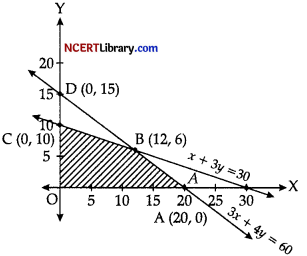
From graph, feasible region is
OABCO, whose corner points are (0, 0), A(20, 0),
B(12, 6) and C(0, 10).
The values of Z at corner points are as follows:
| Corner Points | Value of Z = 80x + 120y |
| 0 (0,0) | Z = 80 x O + 120 x 0 = 0 |
| A (20, 0) | Z = 80 x 20 + 120 x 0 = 1600 |
| 5 (12, 6) | Z = 80 x 12 + 120 x 6 = 1680 |
| C (0, 10) | Z = 80 x 0 + 120 x 10 = 1200 |
From the table, the maximum value of Z is ₹ 1680. Hence, 12 pieces of type A and 6 pieces of type B should be manufactured per week to get maximum profit of ₹ 1680 per week.
![]()
Question 33.
The cost of a TV depreciates by ₹ 800 during the second year and by 700 during the third year. Calculate:
(i) the rate of depreciation per annum.
(ii) the original cost of the TV
(ii) the value of the TV at the end of third year. [5]
Answer:
(i) Let the original cost of the TV be ₹ P and the rate of depredation be r% p.a. Then the value of TV
(in ₹) after 1 year, 2 years and 3 years are P(1 – i)2, P(1 – i)3 and P(1 – i), respectively, where i = \(\frac { r }{ 100 }\)
According to question,
P(1 – i)) – P(1 – i)2 = 800
and P(1 – i)2 – P(1 – i)3 = 700
⇒ P(1 – i)[1 – (1 – i)] = 800
and P(1 – i)2[1 – (1 – i)] = 700
⇒ P(1 – i) i = 800
and P(1 – i)2 i = 700 … (ii)
On dividing eq. (ii) by eq (i), we get
1 – i = \(\frac { 700 }{ 800 }\)
⇒ 1 – i = \(\frac { 7 }{ 8 }\)
⇒ i = 1 – \(\frac { 7 }{ 8 }\)
⇒ i = \(\frac { 1 }{ 8 }\)
∴ \(\frac { r }{ 100 }\) = \(\frac { 1 }{ 8 }\)
⇒ r = \(\frac { 100 }{ 8 }\) = 12.5%
Hence, the rate of depreciation = 12.5% p.a.
(ii) Putting i = \(\frac { 1 }{ 8 }\) in eq. (i), we get
⇒P(1 – \(\frac { 1 }{ 8 }\)) x \(\frac { 1 }{ 8 }\) = 800
⇒ P x \(\frac { 7 }{ 8 x 8 }\) = 800
= 7314.28
Hence, the original cost of TVis ₹ 7314.
(iii) The value of TV at the end of 3rd year = P(1 – i)3
= 7314 (1 – \(\frac { 1 }{ 8 }\))3
= 7314 (1 – \(\frac { 7 }{ 8 }\))3
= \(\frac { 7314 x 7 x 7 }{ 8 x 8 x 8 }\)
= 4899.80 ≈ ₹ 4900
Thus, the value of TV at the end of the 3 year is ₹ 4900.
Question 34.
Suppose that two cards are drawn at random from a deck of cards. Let X be the number of aces obtained. Then the value of E(X). [5]
OR
Five bad oranges are accidently mixed with 20 good ones. If four oranges are drawn one by one successively with replacement, then find the probability distribution of number of bad oranges drawn. Hence, find the mean and variance of the distribution.
Answer:
Let X denotes the number of aces obtained. Therefore, X can take any of the values of 0, 1, or 2. In a deck of 52 cards, 4 cards are aces. Therefore, there are 48 non-ace cards.
∴ P(X = 0) = P(O ace and 2 non-ace cards)

P(X = 1) = P(1 ace and 1 non-ace cards)

P(X = 2) = P(2 ace and 0 non-ace cards)

Thus, the probability distribution is as follows:
| X | 0 | 1 | 2 |
| P(X) | 1128/1326 | 192/1326 | 6/1326 |
Then E(X) = ∑pixi
= 0 x \(\frac { 1128 }{ 1326 }\) + 1 x \(\frac { 192 }{ 1326 }\) + 2 x \(\frac { 6 }{ 1326 }\)
= \(\frac { 204 }{ 1326 }\) = \(\frac { 2 }{ 13 }\)
OR
Total number of oranges = 25
number of good oranges = 20
number of bad oranges = 5
Probability of getting a bad orange,
P(bad oranges) = \(\frac { 5 }{ 25 }\) = \(\frac { 1 }{ 5 }\)
Now p = \(\frac { 1 }{ 5 }\)
q = 1 – p = \(\frac { 4 }{ 5 }\)
Let X be the random variable of “Number of bad oranges”.
or X= 0, 1, 2, 3, 4.
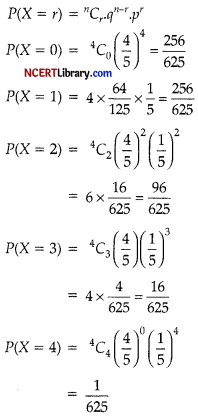
∴Probability distribution is
| X | P(X) | XP(X) | X2P(X) |
| o
1 2 3 4 |
256/625
256/625 96/625 16/625 1/625 |
256/625
192/625 48/625 4/625 |
256,/625
384’625 144/625 16/625 |
∴ Mean = ∑XP(X)
= \(\frac { 500 }{ 625 }\) = \(\frac { 20 }{ 25 }\) = \(\frac { 4 }{ 5 }\)
Var. (X) = E(X2) – [E(X)]2
= \(\frac { 800 }{ 625 }\) – \(\frac { 16 }{ 25 }\)
Var.(X) = \(\frac { 32 }{ 25 }\) – \(\frac { 16 }{ 25 }\) = \(\frac { 16 }{ 25 }\)
Question 35.
Evaluate:
![]()
OR
The demand and supply function of an article are D(q) = 1000 – 0.4q2 and S(q) = 42q. Find the consumer’s surplus and producer’s surplus at equilibrium price.
Answer:
The given difinite integral
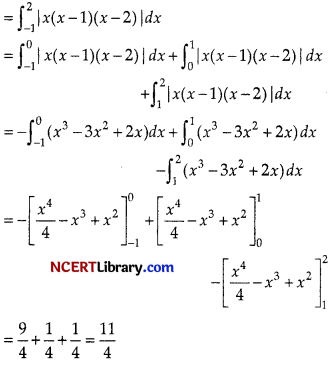
OR
Given, D(q) = 1000 – 0.4q2 and S(q) = 42q
At equilibrium D(q) = S(q)
1000 – 0.4q2 = 42q
or, 0.4q2 + 42q – 1000 = 0
or, 4q2 + 420q – 10000 = 0
or. q2 + 105q – 2500 = 0
or, (q + 125)(q – 20) = 0
q = – 125 or 20
The value of q cannot be negative, q = 20
When q = Qc = 20
D(20) = 1000 – 0.4(20)2
= 1000 – 0.4 x 400
= 1000 – 160 = 840 = Pc
Consumer’s surplus is given by
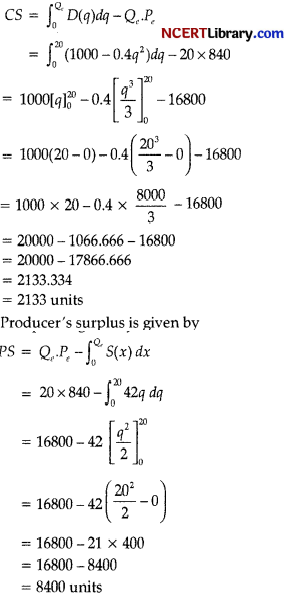
Hence, at equilibrium price, (i) the consumer’s surplus is 2133 units and (ii) the producer’s surplus is 8400 units.
Section – E
All questions are compulsory. In case of internal choice, attempt any one question only
CASE STUDY – I
Question 36.
Sohil is good in Mathematics. His friend gave him a question from the topic Pipes and Cisterns i.e., “Pipe R can empty a full tank in 30 hours. But two pipes P and Q can fill a tank in 15 hours and 10 hours respectively. Ram unknowingly opened all three taps. After 2 hours Shyam realized it and closed Pipe R.”
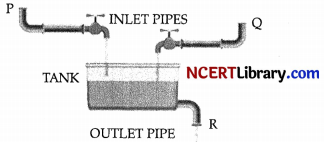
(i) Find the portion the tank is filled by pipes P and Q in one hour, separaiely ? [1]
(ii) Find the portion the tank is filled in one hour, if F,Q and R all are open? [1]
(iii) If R is dosed then entire tank get filled in how much time? [2]
OR
AndtheportionthetanklsfilledintwohcutifCQandRallareopen.
Answer:
(i) Pipe P can fill the tank in 15 hours.
So, in 1 hour tank filled by pipe P = \(\frac { 1 }{ 15 }\)
Pipe Q can fill the tank in 10 hours.
So, in 1 hour tank filled by pipe Q = \(\frac { 1 }{ 10 }\)
(ii) When P, Q and R all are open, then tank filled in 1 hour
= \(\frac { 1 }{ 15 }\) + \(\frac { 1 }{ 10 }\) – \(\frac { 1 }{ 30 }\) = \(\frac { 4 }{ 30 }\)
(iii) If pipe R is closed, then
In one hour tank filled = \(\frac { 1 }{ 15 }\) + \(\frac { 1 }{ 10 }\) = \(\frac { 5 }{ 30 }\)
So entire tank gets filled in \(\frac { 30 }{ 5 }\) = 6 hours
OR
When P, Q and R all are open, then tank filled in
hour = \(\frac { 1 }{ 15 }\) + \(\frac { 1 }{ 10 }\) – \(\frac { 1 }{ 30 }\) = \(\frac { 4 }{ 30 }\)
So,in 2hours = 2 x \(\frac { 4 }{ 30 }\) = \(\frac { 8 }{ 30 }\)
CASE STUDY – II
Question 37.
A trust invested some money in two types of bonds. The first bond pays 10% Interest and second bond pays 12%
interest the trust receIved ₹ 2800 as Interest. However If trust had interchanged money In bonds, they would have
got ₹ 100 less as Interest.

(i) For the given information write the system of equations. [1]
(ii) If the given system of equations can be written as AX = B, then find |A|. [1]
(iii) Find A-1.
OR
Find the total amount invested.
Answer:
(i) According to the questions:
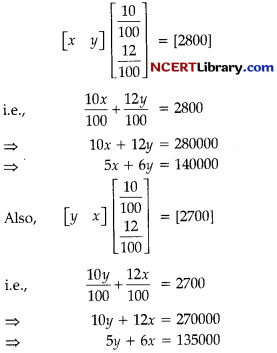
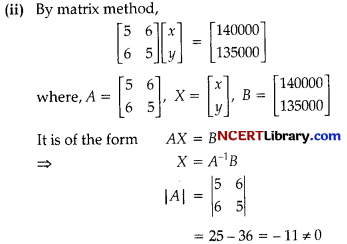
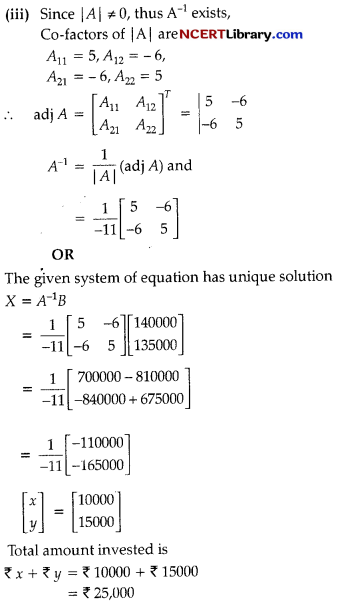
CASE STUDY – III
![]()
Question 38.
A farmer has a piece of land. He observed that he got 600 units of fruits per tree by planting upto 25 trees and when 26 trees were grown, he received 15210 units of fruits, for 27 trees he ended up with 15390 fruits, for 28 trees he got 1554() fruits and this sequence of production of fruits continues in the same pattern as more trees, in excess of 25, were grown.
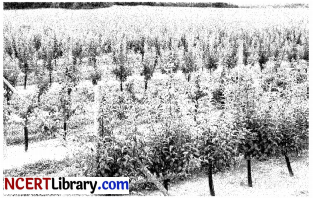
(i) If ‘x’ more trees, in excess of 25 are grown, then find the number of fruits produced per tree. [1]
(ii) Find the product of entire garden if ‘x’ more trees, in excess of 25, are planted. [1]
(iii) Find the marginal production of the garden when ‘x’ more trees, in excess of 25. [2]
Also, find the critical point of producing ‘x’ more units of the tree.
OR
Find the number of tree to be grown to get the maximum production.
Answer:
(i) When no. of trees = 25, then no. of units of fruits per tree = 600
When no. of trees = 26, then no. of units of fruits per
tree = \(\frac { 15210 }{ 26 }\) = 585 = (600 – 15)
When no. of trees = 27, then no. of units of fruits per
tree = \(\frac { 15390 }{ 27 }\) = 570 = (600 – 15 x 2)
When no. of trees = 28, then no. of units of fruits per
tree = \(\frac { 15540 }{ 28 }\) = 555 = (600 – 15 x 3)
Thus, when x more trees, in excess of 25 are grown then the no. of fruits produced per tree is 600 – 15x.
(ii) Option (C) is correct.
Explanation: We know that, if x more tree in excess of 25 are grown. then the number of fruits produced per tree is 6(K) – 15x.
So, the production of entire garden, if ‘x’ more trees, in excess of 25, are planted is given by
p = (25 + x) (600 – 15x)
(ii) Since, P = (25 + x) (600 – 15x)
∴ MarginaI production,
\(\frac { dP }{ dx }\) = (600 – 15x) + (25 + x) (-15)
= (600 – 375) – 30x
= 225 – 30x
For critical point, Put \(\frac { dP }{ dx }\) = 0
i.e., 225 – 30x = 0
x = \(\frac { 225 }{ 30 }\)
= 7.5
OR
\(\frac { dP }{ dx }\) = 225 – 30 x
\(\frac{d^2 P}{d x^2}\) = – 30 < 0
(Production is maximum)
Thus, no. of trees to be grown to get maximum
production is 25 ± x = 25 + 7.5 = 32.5
Hence, required no. of trees = 32 or 33